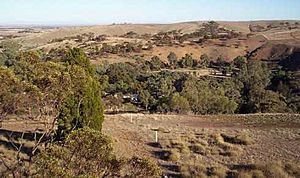Bowman Park facts for kids
Bowman Park is a fun public park in South Australia. It's located near the town of Crystal Brook. The park is about 5 kilometers (3 miles) northeast of the town. It's also about 200 kilometers (124 miles) north of Adelaide, the capital city.
This park covers about 40 hectares (almost 100 acres). It is in the Mid North part of South Australia. The park is named after the Bowman Brothers. They were early settlers who came to this area around 1850.
Contents
Visiting Bowman Park
Bowman Park is open every day from when the sun rises until it sets. It's a great place for families and friends to visit.
What Can You Do at the Park?
The park has many things to make your visit enjoyable.
- You can find clean toilets.
- There are electric barbecues for cooking.
- Dogs are welcome, but they must be on a leash.
One of the best features is the nature playground. It blends right into the natural surroundings. You'll see beautiful river red gum trees all around.
The Crystal Brook
The park is located along the Crystal Brook. This is a creek that usually has water. A permanent spring on the northern side of the park feeds the brook. This means water flows here even when other parts of the creek are dry.
Trails and Wildlife
The famous Heysen Trail passes right through Bowman Park. This is a very long walking trail in South Australia. There's even a lodge inside the park where walkers can stay overnight.
You might see some amazing Australian animals here.
- Kangaroos are often seen in and near the park. The best times to spot them are in the mornings and evenings.
- There is also some evidence of echidnas living in the area. These are unique spiny mammals.
Plants in the Park
Bowman Park is home to many different types of plants. Some of these plants are native to Australia. Others were brought here from different parts of the world.
Sometimes, plants that are not native can spread quickly. These are sometimes called "weed species." In 2005, there was a project to reduce the number of certain non-native trees. These included pepper trees, which had spread a lot. Other non-native plants found here include olive trees and some types of thistles. Willows and certain pine trees are also not native to this environment. Managing these plants helps keep the park healthy for native species.


